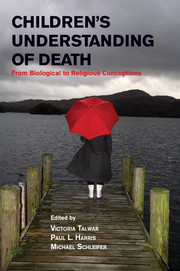Book contents
- Frontmatter
- Contents
- List of Figures and Table
- List of Contributors
- Preface and Acknowledgments
- 1 Death, Ancestors, and the Living Dead: Learning without Teaching in Madagascar
- 2 Death in Spain, Madagascar, and Beyond
- 3 Ambivalent Teaching and Painful Learning: Mastering the Facts of Life (?)
- 4 Death in the Lives of Children
- 5 Talking to Children about Death in Educational Settings
- 6 Responsible Believing
- 7 Thoughts and Feelings: Children and William James Have It Right!
- 8 How the Law Constructs Its Understanding of Death
- Index
- References
2 - Death in Spain, Madagascar, and Beyond
Published online by Cambridge University Press: 03 May 2011
- Frontmatter
- Contents
- List of Figures and Table
- List of Contributors
- Preface and Acknowledgments
- 1 Death, Ancestors, and the Living Dead: Learning without Teaching in Madagascar
- 2 Death in Spain, Madagascar, and Beyond
- 3 Ambivalent Teaching and Painful Learning: Mastering the Facts of Life (?)
- 4 Death in the Lives of Children
- 5 Talking to Children about Death in Educational Settings
- 6 Responsible Believing
- 7 Thoughts and Feelings: Children and William James Have It Right!
- 8 How the Law Constructs Its Understanding of Death
- Index
- References
Summary
Two different research programs have addressed children's developing conception of death. On the one hand, children have been viewed as apprentice biologists who come to view death as an inevitable part of the life cycle. According to this view, which can be traced back to Piaget, children's cognitive development moves toward an objective understanding. Piecemeal observations are increasingly coordinated into a coherent, theorylike organization. More recently, children have also been viewed as apprentice theologians who adopt a spiritual or religious view of death. Indeed, some investigators have suggested that young children are naturally disposed to assume that certain processes continue after death. Others propose that children increasingly understand and endorse the particular claims about the afterlife that are characteristic of their community. In either case, this more recent research assumes that children's developing conception of death cannot be characterized in exclusively biological terms. It embraces various transcendent elements.
I argue that each of these programs makes an important contribution to our understanding of children's ideas about death. What is needed, however, is research on the extent to which these two conceptions – the biological conception on the one hand and the religious conception on the other – coexist in the mind of any individual child. I describe two studies showing that such coexistence is found and indeed increases with age.
- Type
- Chapter
- Information
- Children's Understanding of DeathFrom Biological to Religious Conceptions, pp. 19 - 40Publisher: Cambridge University PressPrint publication year: 2011
References
- 7
- Cited by



